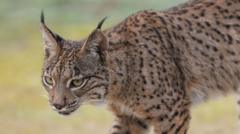The Iberian lynx, once teetering on the edge of extinction, is now showing promising signs of recovery. Among the most elusive wild cats, Navarro, a male lynx with distinctive spots, epitomizes the resilience of his species, which has grown to over 2,000 individuals across Spain and Portugal. This marks a significant improvement from the alarming low of fewer than 100 lynxes a couple of decades ago, a situation compared to the plight of the sabre-toothed tiger.
Rodrigo Serra, who oversees the Iberian lynx reproduction program, emphasizes the dramatic history: at one point, only 25 females of reproductive age existed in two isolated populations. Contributing factors to the decline included agricultural expansion, increased road fatalities, and devastating pandemics that decimated the lynx's primary prey, wild rabbits.
The revival efforts took concrete steps in 2005 when Spain celebrated its first successful litter born in captivity, while Portugal implemented a national conservation plan three years later. A dedicated National Breeding Centre was established in Silves, Algarve, focusing on preparing lynxes for wild life, as well as pairing them for reproduction.
Maintaining a low-stress environment is crucial for the lynxes in captivity, as even minor disturbances can affect them. Serra explains the training regimen, which includes introducing controlled stressors to ensure lynxes remain wary of humans. Feeding mechanisms are designed to keep the animals' reliance on human interaction at a minimum.
Genetic diversity plays a crucial role in the reintroduction process, with careful considerations given to where each lynx is placed to prevent inbreeding. Pedro Sarmento, who has dedicated 30 years to studying the species, notes the unique physical characteristics of the lynx, particularly its small head size relative to its body and large paws—traits that lend themselves to impressive agility.
Despite successes, the reintroduction of lynxes raises concerns among local communities, especially where lynxes may raid chicken coops. As a response, the program coordinators collaborate with landowners to strengthen protections. Individual stories, like that of Lítio, one of the first reintroduced lynxes, illustrate both the challenges and triumphs of these conservation efforts. Lítio's journey between Portugal and Spain shows the fierce instinct of the species, ultimately leading him to thrive and reproduce.
With the Iberian lynx population on the rise, conservationists hope to reach a favorable status by 2035, aiming for 5,000 to 6,000 individuals in the wild. There are significant threats still in play, including a high percentage of lynx deaths attributed to traffic. However, the optimism surrounding the efforts to save the Iberian lynx reflects a broader narrative of successful conservation practices that could serve as a model for other endangered species.


















